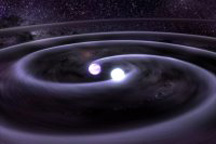Astronomers have once again confirmed Einstein’s Theory of General
Relativity, this time by studying the decaying orbits of a pair of white
dwarf stars.
Einstein predicted that massive objects “bend the fabric” of space and
time, creating the effect we call gravity. One can visualize this by
imaging a taut bed sheet with a bowling ball on its center. The bowling
ball would warp the bed sheet, creating a curved surface that affects
the motion of anything that rolls across it. The illustration below
suggests how our Sun warps the space and time of our solar system,
causing the Earth to move in a circle just as a marble might roll around
the inside of a salad bowl. Einstein said the Sun doesn’t pull on
Earth, as with an invisible rope, but rather the Earth is moving along
the straightest path in the curved space created by the Sun.

Now imagine a spinning barbell in the middle of a bed sheet. The shape
of the bed sheet would constantly change — ripples would move out from
the center as the barbell turned. Something similar happens when two
massive white dwarf stars orbit one another, and we call these ripples
in the fabric of spacetime “gravity waves.” Einstein’s Theory of General
Relativity, which supersedes Newton’s theory of gravity, exactly
predicts the amount of energy carried away by gravity waves. Because
energy is conserved (its total amount never changes), the energy that
the gravity waves carry away has to come from somewhere. In this case,
the orbiting stars lose energy and spiral closer, which reduces their
orbital period (the time required to complete an entire orbit).
Eventually the white dwarfs will merge, possibly forming a neutron star
or black hole.
Starting in 1974, two American astronomers, Russell Hulse and Joseph
Taylor, observed the decreasing period of a pair of orbiting neutron
stars. They received the 1993 Nobel Prize for their exquisitely precise
measurements, which confirmed Einstein’s theory.
The new observation was performed by astronomers from
Harvard-Smithsonian, University of Texas, and the Astrophysics Institute
of the Canary Islands. They studied two white dwarfs that orbit one
another in less than 13 minutes — 765.20654 ± 0.00005 seconds to be
precise. Below is an artist’s sketch produced by NASA of this binary
system, identified as J0651, which lies 3000 light-years away (18,000
trillion miles). White dwarfs are the final stage, the collapsed
remnants, of the least massive and most common stars.

The orbital plane of this binary system just happens to align with our
line of sight, making it particularly easy to make precise measurements
as the stars eclipse one another.
The masses of white dwarfs in this binary system are each 125% of our
Sun’s mass. For the mass and orbital values of this system, Einstein’s
theory predicts the orbital period will decrease by 0.000,26 seconds per
year. The observed decrease is 0.000,31 seconds per year with a
measurement uncertainty of ±0.000,10. Thus theory and observation agree
well within the measurement precision, confirming Einstein’s prediction.
Over the coming years ever more precise measurements will be made on
this system. I’ll gladly wager that Einstein’s theory will hold up.
Let’s stop to consider how remarkable this really is.
Imagine some guy, an unknown government clerk, sitting at a desk, with
only paper and pen. He didn’t have a computer or a telescope and could
only ponder what might be out in the great beyond. At that time, no one
knew anything about white dwarfs or neutron stars; no one even knew what
a neutron was or that stars collapsed when they died. Yet, Einstein was
able to precisely calculate what would happen to such enormous
celestial bodies trillions of miles away.
That’s true genius — a testament to the power of the human mind. Remember, your DNA is 99.9% the same as Einstein.
We can all do amazing things.
Best Regards,
Robert
October 15, 2012
Note: Previous newsletters can be found on my website.
|